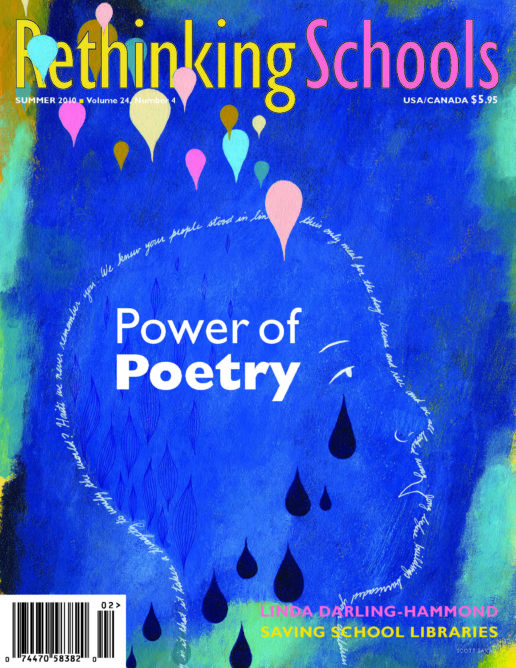Resources 24.4
CURRICULAR RESOURCES
200 Nights and One Day
By Margaret Rozga
(Benu Press, 2009)
75 pp. $16.95
This compact volume of poetry, supplemented by dramatic photos and a crisp timeline, depicts 200 straight days of protests demanding open housing in 1967–68 in Milwaukee—known by some as the “Selma of the North.” Rozga’s poems, which she wrote while participating in the historic struggle, offer stories about the people and the conflict in a way that brings history alive and demonstrates the power of poetry. Foreword by Dick Gregory.

Narrative of the Life of Frederick Douglass,
An American Slave, Written by Himself
A New Critical Edition
By Angela Y. Davis
(City Lights Books, 2010)
245 pp. $12.95
Feminist, scholar, and freedom fighter Angela Davis has republished Douglass’ classic autobiography. Three new interpretive essays will give students and teachers a deeper understanding of Douglass’ significance and the relevance of his thinking to today’s ongoing struggles against racism and for full equality.
Smart by Nature: Schooling for Sustainability
By Michael K. Stone/The Center for Ecoliteracy
(Watershed Media, 2009)
214 pp. $24.95
Smart by Nature argues for radical change in schools’ relationship to the natural world and to food. Our “best hope for learning to live sustainably,” the Center for Ecoliteracy’s Executive Director Zenobia Barlow writes in the preface, “lies in schooling that returns to the real basics: experiencing the natural world; understanding how nature sustains life; nurturing healthy communities; recognizing the consequences of how we feed ourselves and provision our institutions; knowing well the places where we live, work, and learn.” The book offers an overview of what this can mean in practice and then fleshes out this framework with examples from schools across the country. Author Michael K. Stone wrote “Rethinking Lunchtime” in the special Summer 2009 Teaching About Environmental Justice issue of Rethinking Schools.
Place – and Community–Based Education in Schools
By Gregory A. Smith and David Sobel
(Routledge, 2010)
167 pp. $36.95
In an era when the unsustainability of corporate globalization is becoming increasingly obvious, we need to think more about meeting our needs locally, in our own communities. Smith and Sobel’s new book offers valuable examples of how place- and community-based education can address vital student as well as social needs. Such a curriculum is interdisciplinary, problem-posing, and—literally—grounded in students’ lives. This book makes a nice complement to Smart by Nature.
Whitewashing War: Historical Myth, Corporate Textbooks, and Possibilities for Democratic Education
By Christopher R. Leahey
(Teachers College Press, 2010)
145 pp. $22.95
Whitewashing War offers a valuable critique of how today’s corporate textbooks approach the Vietnam War. According to Leahey, just four corporations account for 80 percent of the country’s high school social studies textbooks—and these corporations have a vested interest in how students come to view history and the world today. A helpful chapter offers a critical overview of the textbook industry and its power in shaping what students learn. The heart of the book is an evaluation of how these textbooks describe—well, lie about—U.S. involvement in Vietnam. Leahey shows how publishers avoid including information that might “mar their efforts to establish a patriotic or benevolent imperialist rationale for American involvement.” The book concludes with ideas about teaching the war in Vietnam. (The pioneering work on this subject was the excellent Teaching the Vietnam War [Allanheld, Osmun & Co., 1979] by William Griffen and John Marciano, a book that’s out of print, but worth searching for.)
PICTURE and PHOTOGRAPHY BOOKS

Testing the Ice: A True Story About Jackie Robinson
By Sharon Robinson with illustrations by Kadir Nelson
(Scholastic Press, 2009)
40 pp. $16.99
Testing the Ice is a beautifully illustrated book that briefly tells the story of Robinson’s breaking of the color barrier. At the same time, Testing the Ice describes how bravery appears in everyday life situations—such as Jackie Robinson overcoming his fear of water. The book provides teachers with a means to help students make connections between the heroic social justice actions of notable people like Robinson and the more mundane challenges that everyone faces in their daily lives. The book helps to demystify “famous” people, placing them in a family context with joys and fears similar to those our students face.
Cesar Chavez: A Photographic Essay
By Ilan Stavans
(Cinco Puntos Press, 2010)
96 pp. $13.95
The more than 75 high quality black and white photos in this book should be viewed by all of our students. Taken mainly from the Farm Workers Archives of the Walter P. Reuther Library at Wayne State University, the photos show Chavez as a lifelong activist, a man deeply involved in the workers’ movement. The photos and captions are accessible to children of all ages; the essay is appropriate for high school students.
DVDs

The People Speak—Extended Edition
Directed by Howard Zinn, Chris Moore, and Anthony Arnove
(A&E Home Video, 2009)
http://shop.thepeoplespeak.com
$19.95 for 2 DVD set
110 min. + extras
The People Speak offers readings and performances of letters, diary entries, speeches, and songs from throughout U.S. history. Narrated by Howard Zinn, the readings are by noted actors and musicians, including Matt Damon, Marisa Tomei, Morgan Freeman, Sandra Oh, Bruce Springsteen, Danny Glover, and many more. Based on A People’s History of the United States and Voices of a People’s History of the United States, this DVD is an extended version of the film that aired on the History Channel in December 2009. This is an essential resource for every history teacher.
The Good Soldier
Directed by Lexy Lovell and Michael Uys
(Out of the Blue Productions, 2009)
www.thegoodsoldier.com
79 min. $24.95 (individual price)
As the United States seems embarked on a strategy of war without end, it’s worth remembering that, throughout U.S. history, soldiers have resisted attempts to turn them into mindless killing machines. The Good Soldier offers examples of these too-often-forgotten “good soldiers” who, in different ways, tried to follow their consciences. It’s vital that today’s high school students be exposed to individuals like those featured in this important film.

